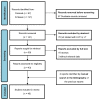Perioperative Complications and Long-Term Follow-Up of Liver Transplantation in Hemorrhagic Hereditary Telangiectasia: Report of Three Cases and Systematic Review
- PMID: 36233492
- PMCID: PMC9573297
- DOI: 10.3390/jcm11195624
Perioperative Complications and Long-Term Follow-Up of Liver Transplantation in Hemorrhagic Hereditary Telangiectasia: Report of Three Cases and Systematic Review
Abstract
The aim was to describe three patients with hemorrhagic hereditary telangiectasia (HHT) requiring liver transplantation (LT) and to perform a systematic review focusing on surgical complications and long-term follow-up. Unrestricted searches of the Medline and Embase databases were performed through February 2022. Forty-five studies were selected including 80 patients plus the three new reported patients, 68 (81.9%) were female and mean age was 50 (27-72) years. Main indications for LT were high-output cardiac failure (n = 40; 48.2%), ischemic cholangitis (n = 19; 22.9%), and a combination of both conditions (n = 13;15.6%). Mean cold ischemic time and red blood cell units transfused during LT were 554 (300-941) minutes and 11.4 (0-88) units, respectively. Complications within 30 days were described in 28 (33.7%) patients, mainly bleeding complications in 13 patients, hepatic artery (HA) thrombosis in four and hepatic vein thrombosis in one. Mean follow-up was 76.4 (1-288) months, and during it, four new patients developed thrombotic complications in HA, HA aneurysm, celiac artery, and the portal-splenic-mesenteric vein. HHT relapse in the transplant allograft was detected in 13 (17.1%) patients after 1-19 years (including two fatal recurrences). Overall mortality was 12%. In conclusion, previous assessment of HA anatomy and hyperdynamic circulatory state could reduce LT complications. The risk of relapse in the hepatic graft supports a multidisciplinary follow-up for HHT patients with LT.
Keywords: angiogenesis; hemorrhagic hereditary telangiectasia; liver transplantation; vascular malformation.
Conflict of interest statement
The authors declare no conflict of interest. The funders had no role in the design of the study; in the collection, analyses, or interpretation of data; in the writing of the manuscript; or in the decision to publish the results.
Similar articles
-
Long-term outcome of patients with hereditary hemorrhagic telangiectasia and severe hepatic involvement after orthotopic liver transplantation: a single-center study.Liver Transpl. 2010 Mar;16(3):340-7. doi: 10.1002/lt.21990. Liver Transpl. 2010. PMID: 20209594
-
Liver Transplantation Trends and Outcomes for Hereditary Hemorrhagic Telangiectasia in the United States.Transplantation. 2019 Jul;103(7):1418-1424. doi: 10.1097/TP.0000000000002491. Transplantation. 2019. PMID: 30335701
-
Liver transplantation for hereditary hemorrhagic telangiectasia: Report of the European liver transplant registry.Ann Surg. 2006 Dec;244(6):854-62; discussion 862-4. doi: 10.1097/01.sla.0000247258.35406.a4. Ann Surg. 2006. PMID: 17122610 Free PMC article.
-
Medical management of haemorrhagic hereditary telangiectasia in adult patients.Med Clin (Barc). 2019 Apr 5;152(7):274-280. doi: 10.1016/j.medcli.2018.09.015. Epub 2018 Nov 27. Med Clin (Barc). 2019. PMID: 30502301 Review. English, Spanish.
-
[Liver involvement in hereditary hemorrhagic telangiectasia].Acta Gastroenterol Latinoam. 2011 Sep;41(3):225-9. Acta Gastroenterol Latinoam. 2011. PMID: 22233000 Review. Spanish.
Cited by
-
Current guidelines for diagnosis and management of hepatic involvement in hereditary hemorrhagic teleangiectasia.World J Hepatol. 2023 May 27;15(5):675-687. doi: 10.4254/wjh.v15.i5.675. World J Hepatol. 2023. PMID: 37305373 Free PMC article. Review.
-
Minimal encephalopathy in hereditary hemorrhagic telangiectasia patients with portosystemic vascular malformations.Orphanet J Rare Dis. 2024 Dec 21;19(1):484. doi: 10.1186/s13023-024-03493-3. Orphanet J Rare Dis. 2024. PMID: 39709450 Free PMC article.
References
-
- Shovlin C.L., Guttmacher A.E., Buscarini E., Faughnan M.E., Hyland R.H., Westermann C.J., Kjeldsen A.D., Plauchu H. Diagnostic criteria for hereditary hemorrhagic telangiectasia (Rendu-Osler-Weber syndrome) Am. J. Med. Genet. 2000;91:66–67. doi: 10.1002/(SICI)1096-8628(20000306)91:1<66::AID-AJMG12>3.0.CO;2-P. - DOI - PubMed
-
- Sánchez-Martínez R., Iriarte A., Mora-Luján J.M., Patier J.L., López-Wolf D., Ojeda A., Torralba M.A., Juyol M.C., Gil R., Añón S., et al. RiHHTa Investigators of the Rare Diseases Working Group from the Spanish Society of Internal Medicine. Current HHT genetic overview in Spain and its phenotypic correlation: Data from RiHHTa registry. Orphanet J. Rare Dis. 2020;15:138. doi: 10.1186/s13023-020-01422-8. - DOI - PMC - PubMed
-
- Alsina-Sanchís E., García-Ibáñez Y., Figueiredo A., Riera-Domingo C., Figueras A., Matias-Guiu X., Casanovas O., Botella L.M., Pujana M.A., Riera-Mestre A., et al. ALK1 Loss Results in Vascular Hyperplasia in Mice and Humans through PI3K Activation. Arter. Thromb. Vasc. Biol. 2018;38:1216–1229. doi: 10.1161/ATVBAHA.118.310760. - DOI - PubMed
-
- Iriarte A., Figueras A., Cerdà P., Mora J.M., Jucglà A., Penín R., Viñals F., Riera-Mestre A. PI3K (Phosphatidylinositol 3-Kinase) Activation and Endothelial Cell Proliferation in Patients with Hemorrhagic Hereditary Telangiectasia Type 1. Cells. 2019;8:971. doi: 10.3390/cells8090971. - DOI - PMC - PubMed


